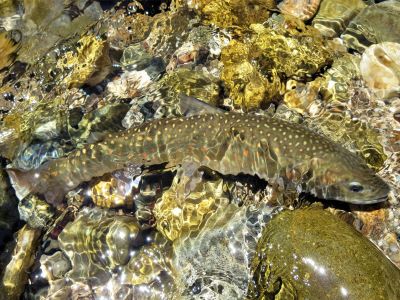But now ask the beasts, and they will teach you; And the birds of the air, and they will tell you; Or speak to the earth, and it will teach you; And the fish of the sea will explain to you. Who among all these does not know That the hand of the LORD has done this, in whose hand is the life of every living thing, And the breath of all mankind? Job 12:7-10
In an earlier post I’ve mentioned that there are times when we call things by names which can be a bit misleading (see Daylily).
Although called a bull trout, the fish pictured above is not really a trout at all. It is a char. Char and trout differ in more ways than one, including a few easy-to-understand differences. For instance, in the northern hemisphere, trout spawn in the springtime, char in the fall. But perhaps the easiest way to identify which is which is by their coloration. In general, trout have light bodies with dark spots. Char have dark bodies with light spots, like the one pictured above. Also, trout have spots on their top (dorsal) fin, and char do not (compare the coloration of this char with that of a cutthroat trout in this post Cutthroat Trout II).
For a fish that does not migrate to the ocean, bull trout can still travel a long way. Some have been tracked migrating well over one hundred miles – from where they are hatched in the stream to where they forage for food, and then back again to their home stream where spawning takes place. In general, these char spawn at higher altitudes in the mountains than do trout. They seek unpolluted, cold (less than 50-degree Fahrenheit) water, clean gravel, and relatively gentle slopes in the stream. These fish usually begin spawning between ages four and seven, and can live for twelve years or more.
Their eggs hatch in the late winter or early spring. Juvenile bull trout eat both aquatic and terrestrial insects. As they grow larger, their diet gradually changes as they begin preying on other fish.
A population of bull trout is a good indicator of clean, unpolluted water – just another reason I am always glad to see them on any fishing adventure. That, plus they grow rather large, and are a lot of fun to catch on a fly rod.
The above Scripture speaks of God creating everything. The final verse is one of special interest to me. The Bible states that in God’s hand is the life of every creature and the breath of all mankind.
That would include me. And you too.
That is a pretty remarkable thing, and a very powerful God. If you would like to know how to have your own relationship with this God, please see Got God.
I hope you have a great day.
